#geothermal
Text
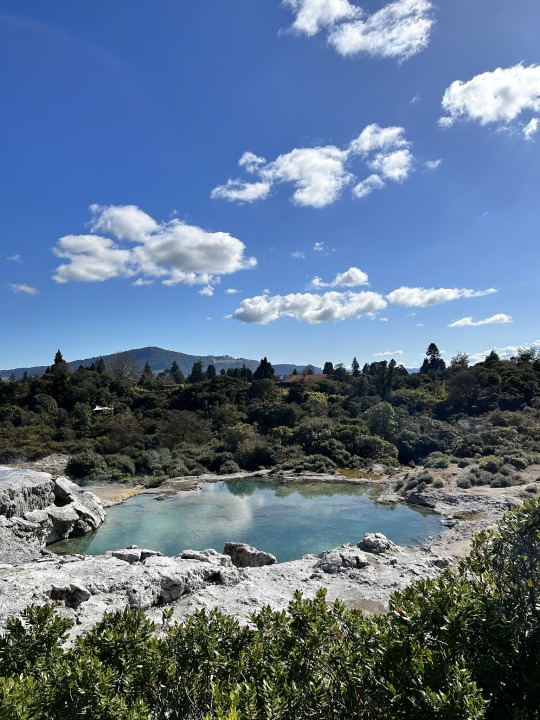
3K notes
·
View notes
Photo

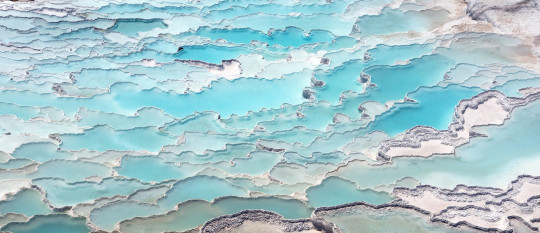
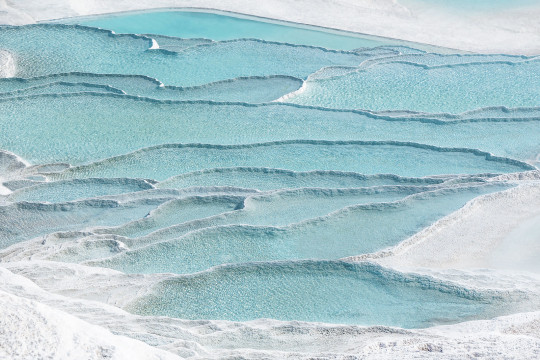


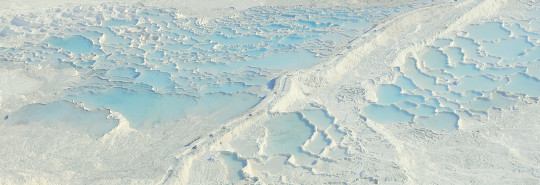
Travertines of Pamukkale, Turkey by Talip Çetin
#landscape#blue#minimal#travel#texture#nature#aesthetic#turkey#geothermal#pools#naturecore#curators on tumblr#uploads
12K notes
·
View notes
Text
Countries That Generate 100% Renewable Energy Electricity
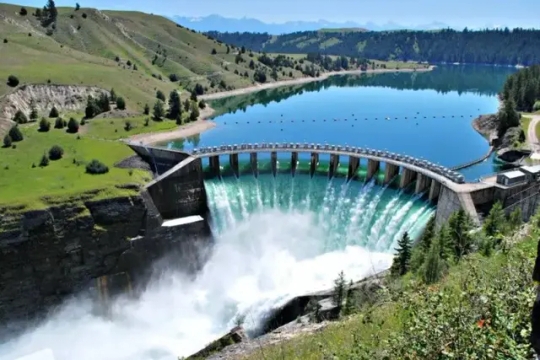
Pictured: Hydropower is the most widely used source of renewable energy-generated electricity. This dam is located near Polson, Montana.
Is 100% Renewable Resource-Generated Electricity Possible?
"With concerns growing regarding burning fossil fuels and their connection to global warming, a great debate is occurring regarding the feasibility of producing electricity entirely from non-carbon emitting green renewable energy sources such as geothermal, hydroelectric, wind, and solar. Skeptics and naysayers claim that achieving such a goal is impractical, would destroy the economy, and is in the realm of pie-in-the-sky thinking.
But is it actually impractical and unattainable? The answer is clearly "no" since there are already several countries that generate 100% of the electricity they use from renewable sources of energy. There are also many other countries that obtain over 90% of the electricity they use from renewable energy sources. Despite the negative rhetoric by some, there’s nothing impractical about using renewable energy to generate electricity on a grand scale.
The Countries Leading the Way to a 100% Renewable Energy Electricity Future
The following is a list of countries that are leading the world into the new frontier of economies that run their electrical grids either entirely or nearly entirely on renewable energy per a 2018 report by the International Renewable Energy Association (IREA) and the U.S. Energy Information Administration (EIA) statistics. This list and the percentages are subject to change over time, but it provides a good snapshot of just how practical renewable energy currently is for electricity generation.
Iceland obtains 100% of the electricity it needs from renewable energy sources. Iceland is somewhat unique since volcanic activity on the island provides a significant geothermal energy source that is utilized to provide approximately one-quarter of the country’s electricity. The remaining three quarters are provided by hydro-power.
Paraguay obtains 100% of the electricity it uses from renewable sources. Huge hydropower dams provide all of Paraguay's electricity needs, as well as supply neighboring Argentina and Brazil with electricity.
Costa Rica is another country leading the way towards 100% renewable-produced electricity. During 2018, Costa Rica met all of its electricity needs using renewable energy sources such as hydro-power, geothermal, biomass, wind, and solar for 300 days in a row.
Ethiopia, Kenya, Namibia, Norway, Tajikistan, and Uruguay are countries currently generating greater than 90% of the electricity they use from renewable energy sources. Some of these countries are working towards running their electric networks entirely from renewable energy.
Some things stand out from the list of countries leading the way in electricity generated from renewable energy.
They are relatively small countries.
They have abundant renewable natural resources, particularly abundant water resources available to generate hydro-power.
The list includes both wealthy developed and poor developing countries.
The fact that both developed wealthy countries and poor developing countries are leaders in renewable energy-produced electricity indicates that the cost of constructing renewable energy resources is not a limiting factor. In fact, developing countries can justify the capital cost of building renewable energy sources of electricity due to the fact that the operating costs are relatively low and predictable (not subject to commodity price swings), and renewable energy allows a country to be self-sufficient in meeting its electricity needs.
Large Developed Countries Can Also Produce 100% Of Their Electricity From Renewable Energy
Critics and naysayers might say that while these achievements by small countries are impressive, implementing renewable energy on a large scale is impractical for larger developed countries. But is it really impractical?
Cost and technological barriers are not what they once were for renewable energy. In fact, costs for renewable energy continue to decline year after year, and renewable energy technologies continue to develop and become more efficient. Many countries have not even come close to tapping their renewable energy potential or even tried some of the technologies available, such as electricity generated by wave or tidal power. Additionally, the argument that renewable energy is only useful when it is being generated is becoming irrelevant since large utility-scale batteries are now available that have the capability to store electricity generated by renewable energy and allow it to be used when needed.
Clearly, the answer is yes. Large developed countries can produce 100% of the electricity they need from renewable sources. It is only a matter of the will and investment at this point to make the changeover from fossil fuel-generated electricity to renewable energy electricity generation. The technical barriers are not as great as naysayers claim, as proven by smaller countries that have already reached the 100% threshold. Moving towards 100% renewable energy sources of electricity will become easier over time as wind, solar, and other renewables become more efficient and large utility-scale battery storage technologies become capable of storing larger quantities of energy for use when needed.
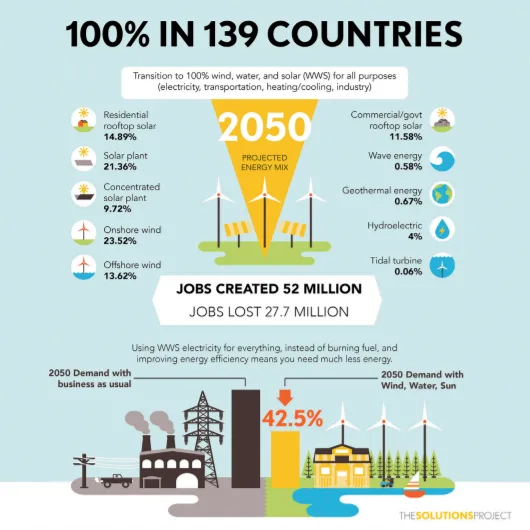
Pictured: Researchers lay out a plan for nearly 140 countries that could be powered 100 percent by renewable energy by 2050. spectrum.ieee.org
The City of Los Angeles Leads the Way in the U.S. With Inexpensive Solar
Various forms of renewable energy have experienced significant cost reductions to a point at which they are competitive and, in some cases, cheaper than traditional electrical energy sources such as coal, oil, and natural gas. This cost reduction trend will accelerate the change over to renewable sources of electricity. For example, the City of Los Angeles signed a deal in July 2019 for a large solar electricity array that will provide 7% of the city's electricity by 2025 at only two cents per kilowatt-hour (kWh). This is far cheaper than fossil fuel-derived electricity.
In addition to being cost-competitive, the practicality and reliability of renewable energy are poised to make major advances as large utility-scale battery technologies are rolled out that can be used to capture renewable energy when it is created, so the electricity can be used at a later time when needed. The Los Angeles solar array project includes utility-scale battery backup at a cost of 1.3 cents per kWh, so the electricity generated by the sun will be available even when the sun is not shining.
Los Angeles has a goal of achieving 100% renewable electricity generation by 2050. This solar contract is a big step toward achieving their goal."
-via TurboFuture, February 21, 2023
#renewables#renewablefuture#renewable energy#clean energy#green energy#solar power#solar panels#fossil fuels#climate crisis#climate change#global warming#hydropower#geothermal#wind power#wind turbines#iceland#paraguay#costa rica#ethiopia#kenya#namibia#norway#tajikistan#uruguay#united states#los angeles#battery#hope posting#hopepunk#sustainability
315 notes
·
View notes
Text

In the Devonian, a Palaeocharinus tuberculatus trigonotarbid hides behind a lycophyte stem as a potentially hungry Eophalangium sheari climbs over from a neighbouring plant.
#paleoart#palaeoart#arachnid#arthropod#trigonotarbid#devonian#rhynie chert#harvestman#geothermal#paleontology#palaeontology#lycophyte#liverwort
273 notes
·
View notes
Text



Boiling sulphuric pits, steam vents and other geothermal activities gives this place its reddish colouration, stinky smell and complete lack of vegetation. Yet amazing and Mars-like vistas (just make sure to arrive super early or super late to avoid the hordes).

Namaskard | Iceland
57 notes
·
View notes
Text
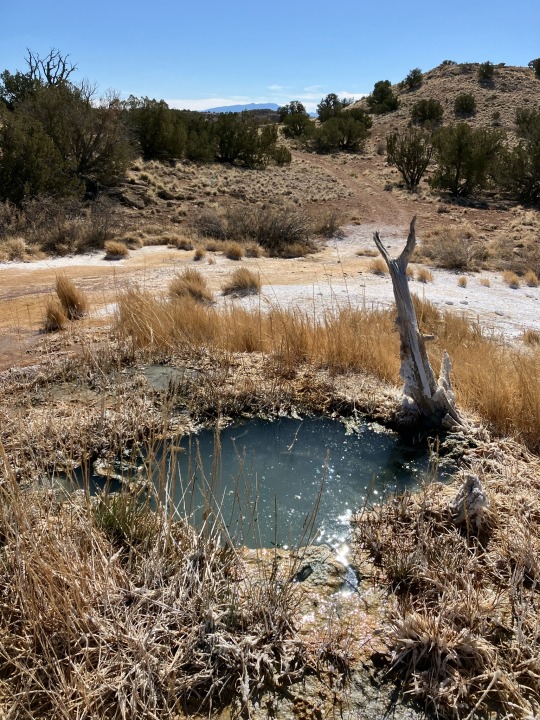

#nature#mountains#hiking#landscape#new mexico#geothermal#warm springs#white ridge#white ridge trails#San ysidro
53 notes
·
View notes
Text



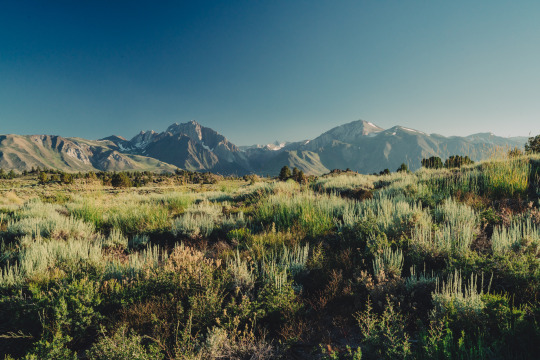
#digital photography#sonya7r4#photographers on tumblr#sonya7riv#color photography#photography#photographers of tumblr#original photography#sage#sage desert#rocks#geology#geothermal
78 notes
·
View notes
Text
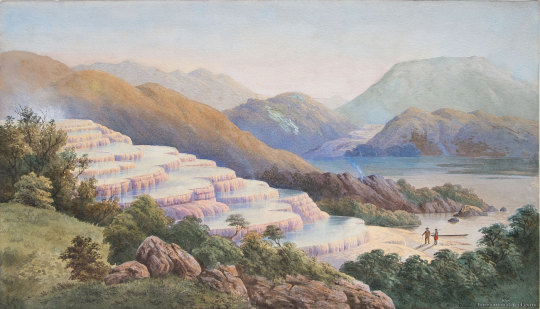
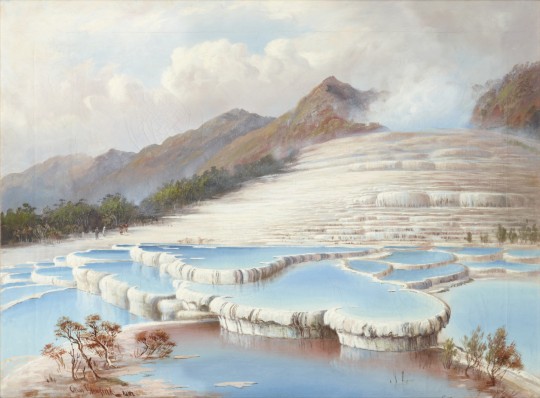
John Barr Clarke Hoyte (British-Australian, 1835 - 1913), Pink Terrace, Rotomahana (New Zealand), watercolour, 40 × 70 cm.
Charles Blomfield (New Zealand, 1848 - 1926), The Pink and The White Terraces, Rotomahana, New Zealand.
70 notes
·
View notes
Text
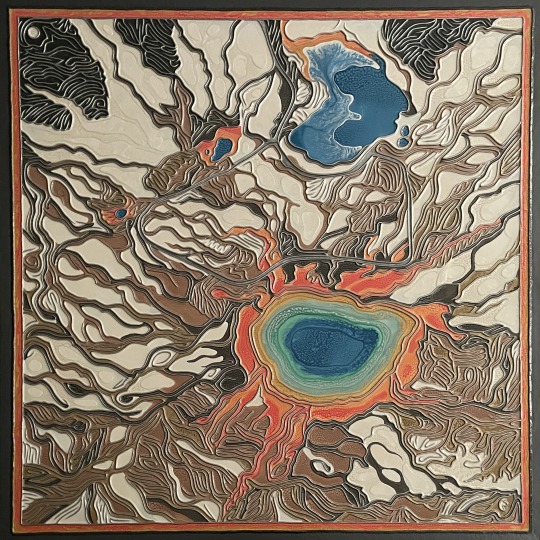
Here's an artwork in LAMINATOR Vol. 1 zine (which has arrived in your mailbox by now if you're local!): A painting called Midway Geyser Basin of Yellowstone by artist Constance Volk (Oak Park, Illinois). Her statement:
"I create textured paintings intended for touch. My paintings begin with a clay foundation, forming channels that allow liquid prismatic oil to flow and marble as it cures, resulting in creations that have the appearance of stone and metal. I call this technique 'channelling'. The channels of these paintings, featuring Yellowstone National Park, form solvable mazes, intended to be travelled by fingertip."
Constance will also have a solo exhibition at Oak Park Public Library where you can see this piece (and others) in person. The show opens today, with a reception tomorrow, and will be on view through April 14. Congratulations, Constance!
LAMINATOR (c) Jenny Lam 2024
#yellowstone#national park#geothermal#colors#nature#hiking#artwork#art#artists on tumblr#clay#travel#zine#art zine#painting#contemporary art#painter#texture#color#contemporary painting#fine art
8 notes
·
View notes
Link
Earth’s interior contains an inexhaustible supply of heat, its many layers continuously warmed by the furnace-like core of our planet. For millennia, humans have tapped into this abundance for cooking food and keeping warm. More recently, over the last century, countries have harnessed geothermal energy to produce electricity from volcanoes in Iceland and Indonesia, underground heat pockets in Kenya, and bubbling hot springs in Italy and the United States.
9 notes
·
View notes
Text
Geothermal area Hveravellir in Iceland
February 02 2023
69 notes
·
View notes
Text
When William Ruto was sworn in as Kenya’s fifth president in September 2022, he used his inauguration speech to demand an end to humanity’s “addiction to fossil fuels” and reaffirmed Kenya’s commitment to reach 100% clean energy by 2030. Kenya is not far off this target today.
In 2021, 81% of Kenya’s electricity generation came from the low carbon sources of geothermal, hydro, wind, and solar power. Over half of this low carbon electricity came from geothermal energy, which Kenya has in abundance. So much in fact, that excess geothermal energy is released during the night when electricity demand is low. Installed geothermal capacity in Kenya could be increased by at least eightfold, which could open opportunities for scaling up green manufacturing capacity or exporting excess electricity to neighbouring countries.
Renewable rollouts have substantially improved energy access. In 2013, around 28% of Kenyans had access to electricity. By 2020, this had risen to over 71%. This was achieved as the population grew by over seven million over the same period, while the rate of urbanisation continued to gather pace. According to the World Bank, barely one million Kenyans had electricity in 1990 [which, back then, was approximately just 5% of the population].
Ruto’s words, and Kenya’s actions, are timely due to the backdrop they are made against. Amid Russia’s invasion of Ukraine, and the vacuum created in global energy markets, European leaders and multinational fossil fuel firms have launched a ‘dash for gas’ across Africa, where a raft of new oil and gas projects, as well as old ones, are being given the green light. At COP27, Ruto kicked back against the dash for gas, stating that “we [Kenya] have taken a position that as a country we are going green and we are well on course.”
-via Rapid Transition Alliance, November 17, 2022
#kenya#green energy#sustainability#carbon emissions#air pollution#africa#world bank#developing nations#electrification#wind power#solar#solar power#geothermal#geothermalpower#fossil fuels#clean energy#good news#hope
224 notes
·
View notes
Text
Trailcam: Rhynie Chert biota, fossil deposit known for it's very detailed fossils of plants and invertebrates due to them being petrified by volcanic hot springs, around 410 million years ago in the early Devonian.


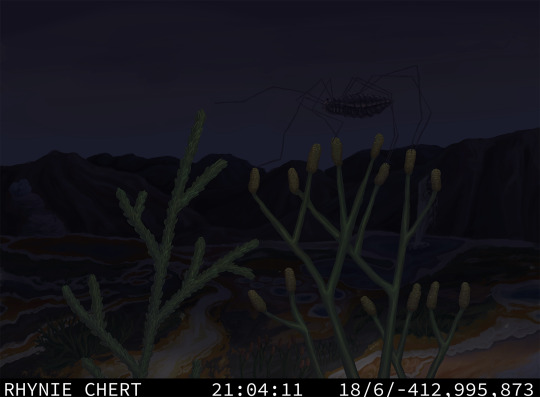
[Image description: A series of digital illustrations of a geothermal landscape with blue and orange geothermal pools and clusters of green plants, with brown mountains in the background. In the front of the image, there are 2 plants close up.
Image 1: At dawn, a Crussolum centipede, a dark blue centipede with long thin legs, reaches up to climb the plant on the left, which has some small Protacarus crani mites, appearing as small pale dots, climbing on the top. Part of a Leverhulmia mariae myriapod, looking like dark green millipede or centipede, is visible at the base of the second plant.
Image 2: As a storm approaches in the day, an orange Palaeocharinus rhyniensis trigonotarbid, a small arachnid that looks like a spider with a flat, segmented abdomen and more small eyes, eats a small bluish white Lepidocaris rhyniensis crustacean, it caught from the edge of a drying up pool.
Image 3: At night, Eophalangium sheari, a harvestman, is silhouetted against the sky as it climbs over the plants.]
#for the paleostream trailcam showcase#paleoart#palaeoart#landscape#not going to tag the individual species because there's so many and I doubt there will be much in their tags anyway so#arachnids#trigonotarbid#myriapods#harvestman#crustacean#geothermal#geology#landscape art#the ib visual art experience of drawing stuff for cas that is just so much better than everything you have for the exhibition. oh well
431 notes
·
View notes
Text

A geothermal dance | Námaskarð, Iceland
#iceland#namaskard#volcanic#thermal#geothermal#photographers on tumblr#original photography#nature#force of nature#photography#namafjall
97 notes
·
View notes
Text


Virkjun og jarðhitalög í hættu vegna eldgossins við Grindavík, 2023.
The upper photo is looking toward the location of the eruptions from about 15 km away but taken 3 months before the lava flows began. The power plant, which stretches over a considerable area, and the geothermal heating system serving SW Iceland are both under severe threat with the main road leading to them already cut by lava flows. The Icelandic government has constructed dikes to divert the lava, but that is uncertain protection.
Having recently read the novel The Fires by Sigríður Hagalín Björnsdóttir (sadly in English, for my command of Icelandic is feeble to say the least) gives me a strong desire to see the volcanic activity currently ongoing on the Reykjanes Peninsula. Wish I could hop on an Iceland Air plane, but that is not going to happen.
7 notes
·
View notes